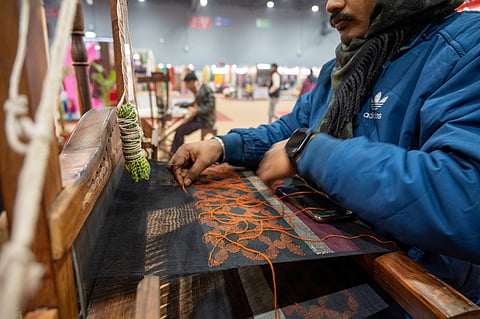
- Destinations
- Experiences
- Stay
- What's new
- Celebrating People
- Responsible Tourism
- CampaignsCampaigns
- Subscribe
- Buy Now

Every year on August 7 in India, we recognise the skills of Indian weavers by observing the National Handloom Day. This day serves as a remarkable testament to India's profound unity in diversity, conveyed by the intricate beauty of Indian handlooms.
The genesis of National Handloom Day can be traced back to 2015 when the Union government designated the day to honour the significance of India's handloom industry and uplift the lives of its weavers. The date is imbued with historical resonance, as it marked the inauguration of the Swadeshi Movement in Kolkata in 1905. This historic moment served as a poignant protest against the Partition of Bengal.
The spectrum of India's handloom masterpieces spans from the Khandua of Odisha to the Muga Silk of Assam, from the Phulia cotton of West Bengal to the Kota Doria of Rajasthan, and extends its reach to Chanderi of Madhya Pradesh and Pochampally of Telangana, and beyond. These diverse threads intricately weave the narrative of India's heritage and cultural tapestry.
"Handloom Day celebrates not only our rich textile heritage but also empowers the new generation with the knowledge and appreciation of the second-largest contributor to India's economy,” said Archana Jaju, Creative Director and Founder of the eponymous label. She added, “As a designer, I support the revival of weaves by blending tradition with contemporary flair in every outfit I create. The pandemic has taught us the value of sustainable and slow fashion, which we follow at Archana Jaju, ensuring ethical sourcing and fair wages for artisans. While machines have their place, the artistry of craftsmanship remains unmatched. Let's all contribute to reducing fashion pollution by embracing conscious consumption and reusing outfits for multiple occasions."
In the intricate world of handlooms, the art of Ikat weaving is held in high regard. Derived from the Indonesian/Malay word "mengikat," meaning to tie or bind, Ikat has traversed continents, gracing Southeast, South, and Central Asia, Japan, and South America. The murals of the Ajanta caves, which are some thousand years old, offer some of the earliest references to the craft.
Historian Archana Roy says the "Lalitavistara Sutra," a Buddhist text dated to the 3rd Century CE, mentions a fabric called "Vichitra Patolaka," which is said to be a reference to Gujarat's "double ikat."
Various regions across India offer their distinct handloom legacies. Gujarat's Patola silk boasts intricate designs that mirror geometric patterns and the beauty of flora and fauna. West Bengal's Baluchari silk is an embodiment of narrative artistry, with tales spun across its borders. Odisha, rich with its Geographical Indication (GI) tagged handlooms, presents the glossy allure of "khandua" from Maniabandha and Nuapatna, the symbolic "pasa" of Bargarh's Pasapali, and the enchanting motifs adorning the Habaspuri from Kalahandi's tribal realm.
Some 95 km from Indore lies a small town still fairly unspoiled by tourists and modern technology. Maheshwar was home to Maratha warrior queen Ahilya Bai Holkar who established it as the seat of an empire. Being a patron of the arts and crafts, she opened her doors to poets, scholars and artists, going as far as setting up a thriving textile industry in the city. Thus began the handloom weaving tradition of Maheshwar, which went on to lend its name to the beautiful, lightweight handlooms.
The slow, laborious weave of Maheshwar textile results in gorgeous, lightweight sarees that are much coveted. Traditionally made in bright colours– like jade greens, canary yellows, crimsons and peacock blues, Maheshwari sarees were woven initially only in pure cotton threads, with pallus (drapes) on both ends, which could be worn either way in case one end frayed. Now, weavers have evolved the process owing to changing demands.
Each region, each thread, unveils a unique chapter in India's handloom narrative. From the intricate texture of Mangalgiri's Andhra Pradesh handlooms to the gossamer finesse of Chanderi in Madhya Pradesh and the regal allure of Kanchipuram silk from Tamil Nadu, Indian handlooms are a symphony of tradition, innovation, and timeless elegance. Whether woven for brides' grace, festive occasions, or everyday elegance, these handlooms stand as living testaments to India's heritage and the remarkable craftsmanship that endures through the ages.
This story was first published in August 2023, and has since been updated.
